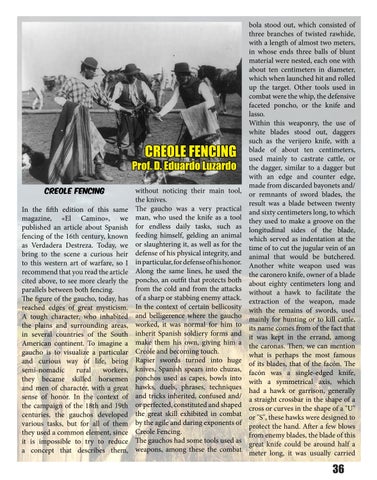CREOLE FENCING
Prof. D. Eduardo Luzardo CREOLE FENCING
In the fifth edition of this same magazine, «El Camino», we published an article about Spanish fencing of the 16th century, known as Verdadera Destreza. Today, we bring to the scene a curious heir to this western art of warfare, so I recommend that you read the article cited above, to see more clearly the parallels between both fencing. The figure of the gaucho, today, has reached edges of great mysticism. A tough character, who inhabited the plains and surrounding areas, in several countries of the South American continent. To imagine a gaucho is to visualize a particular and curious way of life, being semi-nomadic rural workers, they became skilled horsemen and men of character, with a great sense of honor. In the context of the campaign of the 18th and 19th centuries, the gauchos developed various tasks, but for all of them they used a common element, since it is impossible to try to reduce a concept that describes them,
without noticing their main tool, the knives. The gaucho was a very practical man, who used the knife as a tool for endless daily tasks, such as feeding himself, gelding an animal or slaughtering it, as well as for the defense of his physical integrity, and in particular, for defense of his honor. Along the same lines, he used the poncho, an outfit that protects both from the cold and from the attacks of a sharp or stabbing enemy attack. In the context of certain bellicosity and belligerence where the gaucho worked, it was normal for him to inherit Spanish soldiery forms and make them his own, giving him a Creole and becoming touch. Rapier swords turned into huge knives, Spanish spears into chuzas, ponchos used as capes, bowls into hawks, duels, phrases, techniques and tricks inherited, confused and/ or perfected, constituted and shaped the great skill exhibited in combat by the agile and daring exponents of Creole Fencing. The gauchos had some tools used as weapons, among these the combat
bola stood out, which consisted of three branches of twisted rawhide, with a length of almost two meters, in whose ends three balls of blunt material were nested, each one with about ten centimeters in diameter, which when launched hit and rolled up the target. Other tools used in combat were the whip, the defensive faceted poncho, or the knife and lasso. Within this weaponry, the use of white blades stood out, daggers such as the verijero knife, with a blade of about ten centimeters, used mainly to castrate cattle, or the dagger, similar to a dagger but with an edge and counter edge, made from discarded bayonets and/ or remnants of sword blades, the result was a blade between twenty and sixty centimeters long, to which they used to make a groove on the longitudinal sides of the blade, which served as indentation at the time of to cut the jugular vein of an animal that would be butchered. Another white weapon used was the caronero knife, owner of a blade about eighty centimeters long and without a hawk to facilitate the extraction of the weapon, made with the remains of swords, used mainly for hunting or to kill cattle, its name comes from of the fact that it was kept in the errand, among the caronas. Then, we can mention what is perhaps the most famous of its blades, that of the facón. The facón was a single-edged knife, with a symmetrical axis, which had a hawk or garrison, generally a straight crossbar in the shape of a cross or curves in the shape of a "U" or "S", these hawks were designed to protect the hand. After a few blows from enemy blades, the blade of this great knife could be around half a meter long, it was usually carried
36





















